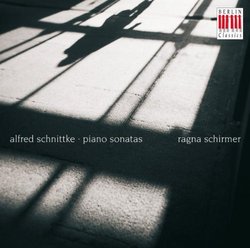| All Artists: Alfred Schnittke, Ragna Schirmer Title: Alfred Schnittke: Piano Sonatas Nos. 1-3 Members Wishing: 1 Total Copies: 0 Label: Berlin Classics Release Date: 2/28/2006 Genre: Classical Styles: Chamber Music, Forms & Genres, Sonatas, Historical Periods, Classical (c.1770-1830), Modern, 20th, & 21st Century Number of Discs: 1 SwapaCD Credits: 1 UPC: 782124172923 |
Search - Alfred Schnittke, Ragna Schirmer :: Alfred Schnittke: Piano Sonatas Nos. 1-3
 | Alfred Schnittke, Ragna Schirmer Alfred Schnittke: Piano Sonatas Nos. 1-3 Genre: Classical |
Larger Image |
CD Details |
CD ReviewsA survey of the damage... villegem | canada | 05/30/2006 (1 out of 5 stars) "Why are musicians so resistant to the composers' scores? What makes them go against it so often? These are questions this CD elicits over and over again.
Schnittke's 1st Piano Sonata is one of the most challenging works in piano repertoire. This recording is a disappointment and doesn't serve this genius music. This pianist lacks a solid technical arsenal required for the piece. Everything in Ragna Schirmer's performance is approximate - tempos, rhythm, pedaling, even notes: there are few wrong notes in the 2nd movement, few wrong clusters in the third... Tempos are never kept throughout the movements (Lento-Allegretto-Lento-Allegro). For instance, the Allegretto of the Second movement starts as Allegretto but then goes every direction depending on the level of technical challenge (meanwhile Schnittke didn't change the tempo once). The climax of the movement with the main theme counter pointed in 4 voices is twice as slow as what indicated by the composer! Within Lentos the pace changes and contributes to feeling often lost in the musical space. Allegro - the Finale's tempo - means obviously faster than Allegretto. However, it doesn't start as Allegro and as the movement progresses it slows down to Andante and even slower. Tempos are important structural columns in organizing a musical time and this tendency to constantly break the time kills any sense and structure of the piece - it's all against the grain. The booklet notes about the works also reflect a common mistake that consists in believing that Schnittke's music is all about gloom and doom. This is a narrow minded vision that is contradicted by others' remarkable interpretations. This music is about awakening. Schnittke's music is strong and encompasses all emotions and spiritual levels from the darkest to the most luminous, innocent and pure. Listen to Irina Schnittke, the composer's widow, playing the Second Piano Sonata (1994 Sony recording with Rostropovich and Lubotsky, with the composer present during the recording sessions): it is strong but never gloomy and Mrs Schnittke through her sensitive touch and intelligence makes this modern language appear so natural, never forced, in one word: classical. She also brings such a tender, playful joy to this music. Listen to Svetlana Ponomarëva's recent releases on ponomarevapianist.com: her rendition of Sonatas No1 and No3 are organic, dynamic, sensitive and imbued of an inner spiritual life. She, for a start, respects the composer and follows the score, and thus offers similar qualities to Mrs Schnittke's rendition of the Second Sonata. We are far from the cold intellectual interpretations of Boris Berman -who first recorded the work- and from the sloppy sight reading effort of Ragna Schirmer. Schnittke's Sonata for Piano No1 has a pure luminous moment before the coda of the second Lento, its third movement. Sadly Ms Schirmer failed to see the light... " |
